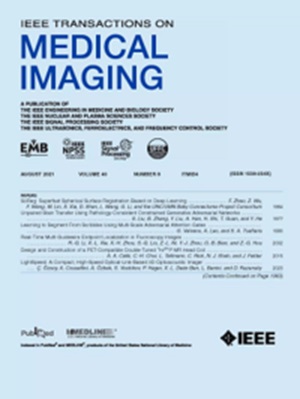Coincidence Counters for Charge Sharing Compensation in Spectroscopic Photon Counting Detectors
IF 8.9
1区 医学
Q1 COMPUTER SCIENCE, INTERDISCIPLINARY APPLICATIONS
引用次数: 9
Abstract
The performance of X-ray photon counting detectors (PCDs), especially on spectral tasks, is compromised by charge sharing. Existing mechanisms to compensate for charge sharing, such as charge summing circuitry or larger pixel sizes, increase and aggravate pileup effects. We propose a new mechanism, the coincidence counting bin (CCB), which does not increase pileup and which has implementation similarities to existing energy bins. The CCB is triggered by coincident events in adjacent pixels and provides an estimate of the double counts arising from charge sharing. Unlike charge summing, the CCB does not directly restore corrupted events. Nonetheless, knowledge of the number of coincident counts can be used by the estimator to reduce noise. We simulated a PCD with and without the CCB using Monte Carlo simulations, modeling PCD pixels as instantaneous charge collectors and X-ray energy deposition as producing a Gaussian charge cloud with 75 micron FWHM, independent of energy. With typical operating conditions and at low flux (120 kVp, incident count rate 1% of characteristic count rate, 30 cm object thickness, five energy bins, pixel pitch of 300 microns), the CCB improved dose efficiency of iodine and water basis material decomposition by 70% and 50%, respectively. An improvement of 20% was also seen in an iodine CNR task. These improvements are attenuated as incident flux increases and show moderate dependence on filtration and pixel size. At high flux, the CCB does not provide useful information and is discarded by the estimator. The CCB may be an effective and practical mechanism for charge sharing compensation in PCDs.用于光谱光子计数探测器电荷共享补偿的重合计数器
X射线光子计数探测器(PCD)的性能,特别是在光谱任务中,受到电荷共享的影响。补偿电荷共享的现有机制,如电荷求和电路或更大的像素大小,会增加并加剧堆积效应。我们提出了一种新的机制,即重合计数仓(CCB),它不会增加堆积,并且在实现上与现有的能量仓相似。CCB由相邻像素中的重合事件触发,并提供由电荷共享引起的双倍计数的估计。与费用相加不同,CCB不直接恢复损坏的事件。尽管如此,估计器可以使用重合计数的数量的知识来减少噪声。我们使用蒙特卡罗模拟模拟了有和没有CCB的PCD,将PCD像素建模为瞬时电荷收集器,将X射线能量沉积建模为产生具有75微米FWHM的高斯电荷云,与能量无关。在典型的操作条件下,在低通量(120kVp,入射计数率为特征计数率的1%,30cm物体厚度,五个能量仓,像素间距为300微米)下,CCB将碘和水基材料分解的剂量效率分别提高了70%和50%。碘CNR任务也有20%的改善。这些改进随着入射通量的增加而减弱,并且显示出对滤波和像素大小的适度依赖性。在高通量下,CCB不提供有用的信息,并且被估计器丢弃。CCB可能是PCD中电荷共享补偿的有效且实用的机制。
本文章由计算机程序翻译,如有差异,请以英文原文为准。
求助全文
约1分钟内获得全文
求助全文
来源期刊

IEEE Transactions on Medical Imaging
医学-成像科学与照相技术
CiteScore
21.80
自引率
5.70%
发文量
637
审稿时长
5.6 months
期刊介绍:
The IEEE Transactions on Medical Imaging (T-MI) is a journal that welcomes the submission of manuscripts focusing on various aspects of medical imaging. The journal encourages the exploration of body structure, morphology, and function through different imaging techniques, including ultrasound, X-rays, magnetic resonance, radionuclides, microwaves, and optical methods. It also promotes contributions related to cell and molecular imaging, as well as all forms of microscopy.
T-MI publishes original research papers that cover a wide range of topics, including but not limited to novel acquisition techniques, medical image processing and analysis, visualization and performance, pattern recognition, machine learning, and other related methods. The journal particularly encourages highly technical studies that offer new perspectives. By emphasizing the unification of medicine, biology, and imaging, T-MI seeks to bridge the gap between instrumentation, hardware, software, mathematics, physics, biology, and medicine by introducing new analysis methods.
While the journal welcomes strong application papers that describe novel methods, it directs papers that focus solely on important applications using medically adopted or well-established methods without significant innovation in methodology to other journals. T-MI is indexed in Pubmed® and Medline®, which are products of the United States National Library of Medicine.
 求助内容:
求助内容: 应助结果提醒方式:
应助结果提醒方式:


